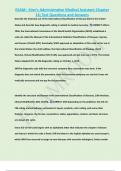EXAM: Kinn's Administrative Medical Assistant Chapter
16; Test Questions and Answers
Describe the historical use of the International Classification of Disease (ICD) in the United
States and describe how diagnostic coding is related to medical necessity. CORRECT ANS-In
1946, the International Commission of the World Health Organization (WHO) established a
code set called the Manual of the International Statistical Classification of Diseases, Injuries,
and Causes of Death (ICD). Eventually, WHO approved an adaptation of this code set for use in
the United States; the ninth edition, the International Classification of Diseases, Ninth
Revision, Clinical Modification (ICD-9-CM), was approved and put into use in 1975. The United
States adopted ICD-10-CM diagnostic coding on October 1, 2015.
349The diagnostic code tells the insurance company why a procedure was done. If the
diagnosis does not match the procedure, then the insurance company can say that it was not
medically necessary and not pay for the procedure.
Identify the structure and format of the International Classification of Diseases, 10th Revision,
Clinical Modification (ICD-10-CM). CORRECT ANS-Depending on the publisher, the ICD-10-
CM coding manual will vary somewhat in layout, symbols, color coding, and some other
features. However, the format, conventions, tables, appendixes, content, and basic structure
are always the same.
Every ICD-10-CM code begins with an alphabetic letter that indicates the chapter of disease
and injury in which the code is listed. (All the letters in the English alphabet are used except U,
which WHO has reserved to assign to new diseases with uncertain etiologies.) Codes contain
, EXAM: Kinn's Administrative Medical Assistant Chapter
16; Test Questions and Answers
up to 7 alphanumeric characters; the first 3 characters are followed by a period. Codes that
require a 7th character may use an X as a placeholder for the 4th, 5th, and 6th characters if no
other code can be used for those characters.
Describe how to use the Alphabetic Index to select main terms, essential modifiers, and the
appropriate code (or codes) and code ranges. CORRECT ANS-The ICD-10-CM Index to
Diseases and Injuries (commonly called the Alphabetic Index) consists of an alphabetic list of
diagnostic terms and related codes. This index includes main terms, nonessential modifiers,
essential modifiers, and subterms. Fig. 16.3 provides an example of the main term Colitis;
which is followed by the nonessential modifiers (acute), (catarrhal), (chronic), (noninfective),
and (hemorrhagic). The second essential modifier listed under the main term is "amebic
(acute)," and the subterm listed under amebic is "nondysenteric." The main term is bold face;
the nonessential modifiers that follow it are enclosed in parentheses; the essential modifier is
indented one space under the main term; and the subterm is indented one space under the
essential modifier (two spaces under the main term). The nonessential modifiers (i.e., acute,
catarrhal, chronic, noninfective, and hemorrhagic) do not affect the code assignment. The
hyphen (-) at the end of the code indicates that additional characters are required to complete
the code.Explain how to use the Tabular List to select main terms, essential modifiers, and the
appropriate code (or codes) or code ranges.




